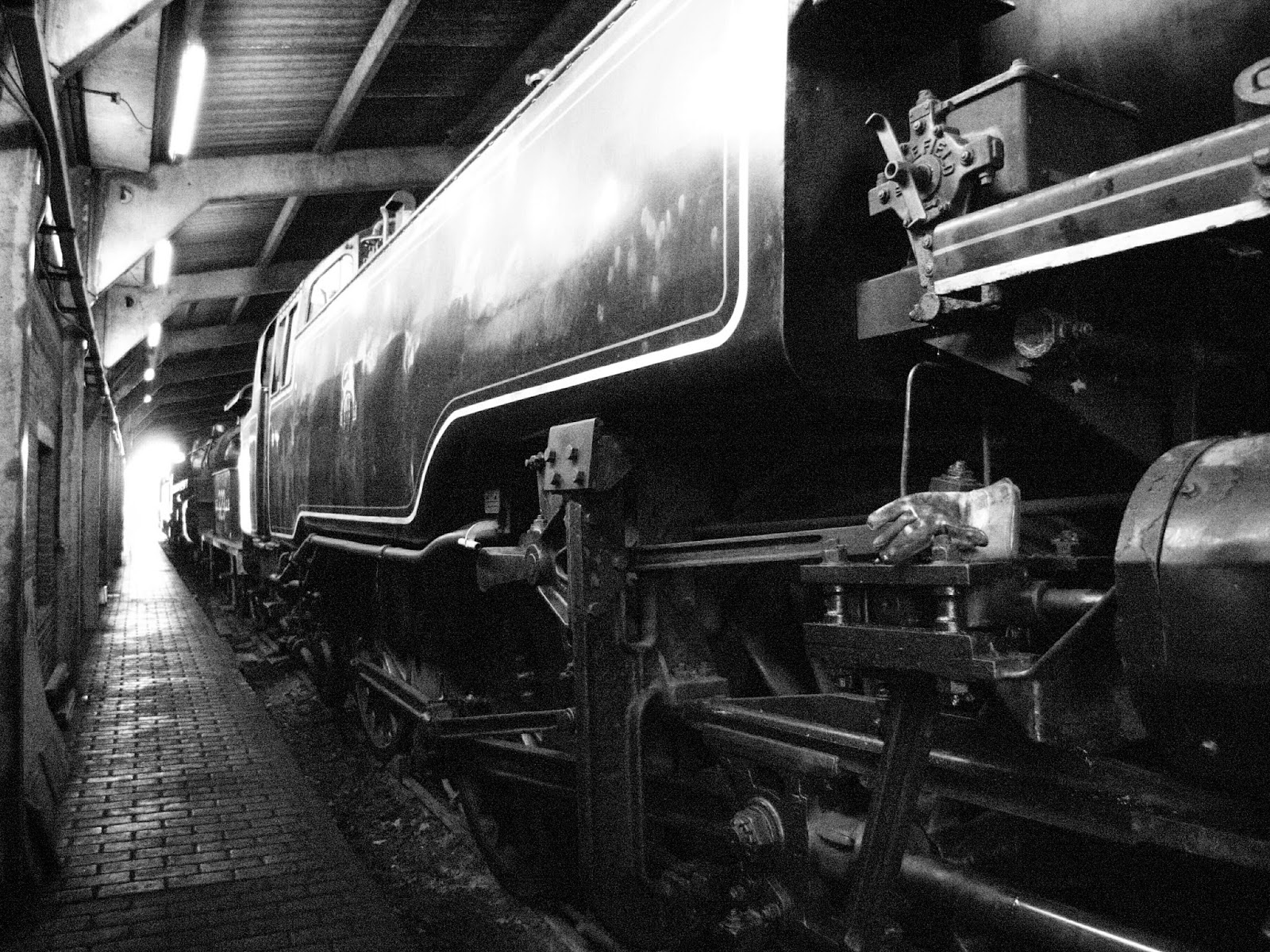I never was mechanically-minded, nor in any way drawn to machinery from the 'how does it work' or 'how can I fix this' points of view. A question like 'what can it do for me' was however more relevant. And I was always interested in 'what does it look like', because this brings in design and aesthetic considerations. So I have always admired the huge steam machines that Victorian engineers created for pumping water and other tasks. They were not only functional, but satisfyingly good to look at, especially when in motion, and made wonderful photographic subjects.
In the UK the most ubiquitous objects of this type are of course steam locomotives on preserved railway lines. I'm very lucky to have the Bluebell Railway just twenty minutes away. This is a standard-gauge line, that runs from East Grinstead (at the northern edge of Sussex, where it directly connects with the national railway system) southward (in the Lewes direction) to Sheffield Park, which is their HQ. Sheffield Park station has the engine shed. You can go and visit it at any time of the year, and walk up and down the lines of locomotives. I suppose that if you are a railway engine enthusiast this must be nirvana. Myself, I go to shoot the locomotives because they - or rather bits of them - make very good photographs. I don't go that often, but I did on impulse last month, after returning from North Devon.
Of course, not even I can resist some 'ordinary' pictures of these impressive monsters.
Nor indeed any work being done on them. In this shot, an old hand was (I think) showing a new volunteer how to service a smokebox:
But just as impressive (and visually intriguing) are the well-engineered metal bits that make up the whole. Some are clearly to do with pressure-management and lubrication, others with the brute transmission of gigantic mechanical force:
As you can see, I often prefer shooting in gritty black-and-white for this kind of shot. My Leica D-Lux 4 has a valuable 'film-grain' option that simulates how it would be if I were taking pictures using a 'fast' film in the old film-camera days. That sort of film gave you big crystals and a characteristic speckled effect, which tended to pump up the contrast and could, with the right subject, make it seem hyper-sharp. Very suitable for greasy metallic shafts and levers and rods and nuts and bolts!
It's a bit stark, though! Eventually, one needs to get back to a bit of colour!
The old steam machines certainly had strong visual impact, and for me that's the big attraction. Even more so when they are in motion, and belching smoke. But they are arresting subjects, even at rest, and make such a good composition. I don't really think that modern stuff, like (for instance) the latest passenger aircraft that look like chubby flying whales, made of the lightest possible materials, and stuck together with glue, can compare. You might as well enthuse over the latest kind of bus. And you know what I think about buses!


%2BBluebell%2BRailway%3B%2BSheffield%2BPark%3B%2Bloco%2Bshed.JPG)
%2BBluebell%2BRailway%3B%2BSheffield%2BPark%3B%2Bloco%2Bshed.JPG)
%2BBluebell%2BRailway%3B%2BSheffield%2BPark%3B%2Bloco%2Bshed.JPG)
%2BBluebell%2BRailway%3B%2BSheffield%2BPark%3B%2Bengine%2Bshed.JPG)
%2BBluebell%2BRailway%3B%2BSheffield%2BPark%3B%2Bengine%2Bshed.JPG)
%2BBluebell%2BRailway%3B%2BSheffield%2BPark%3B%2Bengine%2Bshed.JPG)
%2BBluebell%2BRailway%3B%2BSheffield%2BPark%3B%2Bengine%2Bshed.JPG)




%2BBluebell%2BRailway%3B%2BSheffield%2BPark%3B%2Bloco%2Bshed.JPG)
%2BBluebell%2BRailway%3B%2BSheffield%2BPark%3B%2Bengine%2Bshed.JPG)
%2BBluebell%2BRailway%3B%2BSheffield%2BPark%3B%2Bengine%2Bshed.JPG)
%2BBluebell%2BRailway%3B%2BSheffield%2BPark%3B%2Bengine%2Bshed.JPG)
%2BBluebell%2BRailway%3B%2BSheffield%2BPark%3B%2Bengine%2Bshed.JPG)
%2BBluebell%2BRailway%3B%2BSheffield%2BPark%3B%2Bengine%2Bshed.JPG)
%2BBluebell%2BRailway%3B%2BSheffield%2BPark%3B%2Bengine%2Bshed.JPG)
%2BBluebell%2BRailway%3B%2BSheffield%2BPark%3B%2Bengine%2Bshed.JPG)
%2BBluebell%2BRailway%3B%2BSheffield%2BPark%3B%2Bengine%2Bshed.JPG)
%2BBluebell%2BRailway%3B%2BSheffield%2BPark%3B%2Bengine%2Bshed.JPG)
%2BBluebell%2BRailway%3B%2BSheffield%2BPark%3B%2Bengine%2Bshed.JPG)
%2BBluebell%2BRailway%3B%2BSheffield%2BPark%3B%2Bengine%2Bshed.JPG)
%2BBluebell%2BRailway%3B%2BSheffield%2BPark%3B%2Bengine%2Bshed.JPG)
%2BBluebell%2BRailway%3B%2BSheffield%2BPark%3B%2Bengine%2Bshed.JPG)
